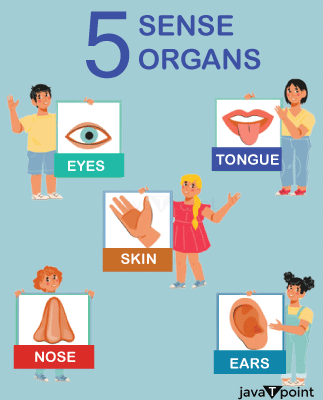What are the Sense Organs?Sensory cells make up the specialised organs known as sense organs, which react to environmental stimuli by sending impulses to the body's sensory system. Multiple tasks are conducted by sense organs, which also help us perceive our surroundings. These are vital components of our bodies that provide us the ability to perceive our surroundings. A variety of sensations are produced by the sense organs and their receptors, which are subsequently communicated to the brain. In reaction to a specific physical phenomenon, data is processed by a complex network of neurons and sensory organs. This is how we engage with and respond to our surroundings. The names of our five main sensory organs are as follows:

The awareness of sound, light, smell, taste, and touch, in that sequence, is aided by the traditional five senses. There are two types of receptors in the sense organs: General Receptors and Specific Receptors. Both can transmit signals to sensory nerves. Specialised sense organs like the eyes for vision, ears for hearing and balance, tongue for taste, and nose for scent are fitted to receptors. There are no specific sense organs; all general senses are interconnected with the sense of touch. There are touch or general receptors all throughout the body (skin). The development of a sense organs chart will help with comprehension of the sense organs and how they work. Our Five Sensational OrgansOur five sense organs may receive and transmit sensory information to the brain. A living thing's ability to perceive information through its senses is crucial. The five senses and how they work are described in more detail below: 
1. Ears- Sensory System for Hearing (Audioception)The auditory sense organs, or ears, are essential for hearing and understanding sounds. Our auditory system detects air vibrations or sound waves, which subsequently assists us in hearing noises. The inner ear houses the vestibular system, which is frequently referred to as the organ of balance, making it essential for our sense of equilibrium. The ear consists of the following three parts:
2. Eyes- Sensory System for Vision (Ophthalmoception)All light images are detectable by the eyes, which also gather information from their environment to deliver to the brain for analysis. This light is transformed into meaningful information by the brain, enabling you to determine an object's brightness, colour, or distance. The two eye layers that let light to enter are the cornea and lens. Both layers work together to focus the light ray into a spot on the retina, which is located at the back of the eye. The first layer is put at the front of the eye, while the second layer is placed precisely behind the pupil. Photoreceptors become active when light is focused on the retina, producing visual stimuli. The following are the two categories of photoreceptors:
3. Tongue: Taste Sensory System (Gustaoception)Because taste buds occur on the tongue, it is one of our sensory organs that helps us perceive tastes and flavours. The papillae on the tongue are taste receptors that help people identify different flavours. The nose and tongue are linked to taste perception and collaborate to produce a flavour. Taste buds have chemoreceptors, which function similarly to the nasal cavity's receptors. The key distinction is that the tongue has four separate taste buds for identifying various flavours, including salty, sweet, bitter, and sour. 4. Nose- Sensory System for Smell (Olfacoception)The nose, commonly referred to as the olfactory organ, helps people detect a variety of odours. It is a component of the body's respiratory system and aids in taste perception. The brain perceives and categorises various odours as air passes over olfactory cells (chemoreceptors) when we breathe through our noses. To clear mucus from the sinuses and the back of the nose, cilia, also known as nose hairs, move back and forth. 5. Skin- Sensory System for Touch (Tactioception)The skin's sensory system is known as tactioception. Tactioception, the sense of touch, is related to skin, which is our body's largest sense organ. The flexible outer skin of the body is where the glands, nerves, and hair follicles are located. The three main functions of skin are regulation, sensibility, and protection. Surface temperature, pain, physical contact, and chemical stimuli are all detected by sensory nerve structures or receptors. The skin consists of the mainly three layers:
Other Sensational OrgansIn addition to the five senses and the roles described above, other sensory organs let us sense a variety of experiences. The following are the other two sensory systems that communicate with the brain in distinct ways:
The article's main point is that sense organs are essential to the survival of the human being. All five of the main senses have been covered.
Next TopicWhy is Xylem called the Dead Tissue?
|
 For Videos Join Our Youtube Channel: Join Now
For Videos Join Our Youtube Channel: Join Now
Feedback
- Send your Feedback to [email protected]
Help Others, Please Share









